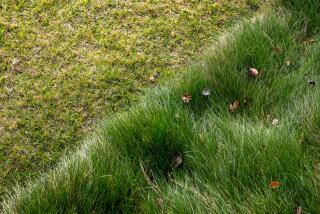GREEN THUMBS
For Paul Latshaw, little is more exciting than watching grass grow, as long as it’s growing on the greens at Riviera.
It hasn’t always, which is why Latshaw has spent the last seven months as a bicoastal superintendent, commuting between the troubled twins: his home base at Congressional in Bethesda, Md., and Riviera, which has borrowed him and would prefer not to return him.
They have been courses with major problems, and Latshaw has offered major solutions to get them ready for major events.
Such as this week’s U.S. Senior Open.
“I was sort of familiar with its problems,” he says of his decision to take on Riviera. “Congressional went through an era of criticism, people saying we weren’t going to be ready for the U.S. Open.
“We had the senior Open there, and it wasn’t the most successful senior Open because of the condition of the golf course. So you always look for another club with similar problems.
“Congressional and Riviera, we were the two clubs with the bad greens. I came out here a couple of times to see how they were addressing their problems to see how we could correct ours at Congressional.”
Basically, he found that whatever was being done at Riviera was something he sure didn’t want to do at Congressional. Both courses have poa annua greens, and both want bent grass. You can control bent, but poa annua is a weed with a mind of its own.
Riviera’s greens had management red with embarrassment after the 1995 PGA Championship, when players found that every step left the grass looking like cactus. In technical terms, the greens were spiking up.
“It was well-known that we had greens problems,” said Michael Yamaki, an officer with the Marukan Corp., which owns Riviera. “Then after the PGA, the greens burned up.”
It probably should have been arson.
Theories abound, the most popular of which was that the new greens were sodded to keep the members playing, rather than seeded, to allow the grass to take root. Yamaki says Congressional seeded its greens, then had the same problems Riviera’s sodded greens had.
Whatever, it was clear where the Marukan folks had to go to fix it.
“I talked with several people, and Latshaw’s name kept coming up,” Yamaki said.
Said Tom Meeks, who spent Sunday plotting pin placements and investigating the greens for the USGA: “If they can’t get to the firmness we need and not spike up like the PGA with Paul Latshaw, they can’t be done.”
High praise for a would-be chicken farmer, who came to appreciate working with grass after four years in the Navy.
Latshaw, who grew up in Pennsylvania-Dutch country, had planned to enroll at Penn State to study poultry husbandry and follow in his father’s footsteps, until his dad one day talked about the financial future of chicken farming.
“So I went up the unemployment office in Sunbury, Pa., and the guy says, ‘You know, with a farm background, there’s a new golf course being built here and they’re looking for people,’ ” Latshaw says.
“So I went to the golf course, the first one I’ve ever been on in my life. I remember the superintendent saying, ‘This is a green.’ And I said, ‘Well, this is a green.’ I had never been on a golf course, but rather than taking up poultry husbandry, I got into turf grass. I was a laborer. Did everything.”
From Frosty Valley Country Club, Latshaw made his way to Jackson, Mich., and to Cleveland before going on to venerable Oakmont, and to his first appointment with a major tournament. It was the 1978 PGA Championship, and five years later the course hosted the U.S. Open.
His fame spread, and Augusta National called.
After five years there, family pressures called him to Wilmington, Del., to an affluent course down on its luck, a layout that wife Phyllis remembers fondly because there were no major championships eating up his time.
It was a major void in his life.
“I was there about three years and I started getting bored,” he says. “When Congressional called, I jumped. They had just made the commitment about a year before for the senior Open and U.S. Open, and I thought that was good, getting both opens. I personally thought that after that was over, I was going to call it quits. To retire.”
Then Riviera called.
“I guess I’m a glutton for punishment,” he says, laughing.
Latshaw and his son, Paul Jr., superintendent at Merion, site of four U.S. Opens, came out to take a look last fall.
“We toured the golf course and at the end of the day, they asked us, ‘Can it be done?’ And my son said, ‘I don’t think so.’
“But I thought it could and I think it has been done. . . . After this is over, I think I’ll pinch myself and say, ‘Did we really do this?’ ”
“This” was bring out six interns and immediately instigate an aerification program for the greens, taking out 3 1/2-inch-deep plugs and filling the holes with nutrient-enriched top-dressing.
That was done in January and repeated in February and March.
“We put a program in here that was condensed,” he says. “We had put one in at Congressional and it took us five years there to get the greens the way we wanted. So I figured that I needed a condensed version of the same program here to get ready in six months’ time.
“We knew we had to be aggressive, and it’s not as much as I’d like. We did the same process at Congressional and did it 30 times. But with the time we had, I felt that would be sufficient.”
He also trained staff, bought additional equipment and added to the maintenance shed at Riviera.
He sized up the rough, which is largely the kikuyu grass for which Riviera is famed, but which also is fescue and rye grass that has blown in over time since the course was opened in 1929.
Each of the grasses presents a different problem for the players, exacerbated by the USGA edict that the rough be 3 1/2 inches high. At that, it’s about 2 1/2 inches shorter than rough for a U.S. Open.
All the while, Latshaw kept up a weekly commute, leaving Los Angeles at noon on Friday for Congressional, where he put in a full Saturday and a half-day Sunday before heading west again.
“I haven’t had a day off this year,” he says.
He has been approached about staying at Riviera but hasn’t committed because he has two years remaining on his contract with Congressional.
This week, greens will be double-cut and rolled to try to get them to a slick 12 on the Stimpmeter, and fairways will be mowed to half an inch, about an eighth of an inch higher than he would like, but all the course will take for now.
“I can’t say this is going to be a Masters, as far as time to get it ready, to make it perfect,” Latshaw says. “I think my last three years at Augusta and the Open in ’83 at Oakmont and the Open at Congressional, I think I can say I had perfect courses.
“We’re not going to have that here. If we had lots of time and lots of money, we could have. But the management company here has given us plenty of resources, and I think we’re going to give a real good showing for the time we’ve had to work with it.”
More to Read
Go beyond the scoreboard
Get the latest on L.A.'s teams in the daily Sports Report newsletter.
You may occasionally receive promotional content from the Los Angeles Times.










